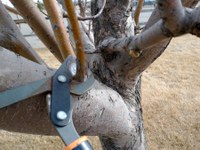Dakota Gardener: When Pruning Apple Trees, Keep it Simple
(Click an image below to view a high-resolution image that can be downloaded)
By Tom Kalb, Horticulturist
NDSU Extension
Do you have an old apple tree in your backyard? Prune it now and you will rejuvenate it.
This is the best time of the year to prune a fruit tree. The tree is dormant and will suffer less shock. You easily can see the branches now, and no wound dressings will need to be applied.
If you wait until the leaves appear, you may spread diseases in the tree when you make cuts with your pruners.
Pruning a fruit tree is not complicated. Don’t worry about making a mistake. The tree will survive. Let’s keep it simple.
Our goal is to get more sunlight and wind inside the tree. The sunlight will give us more flowers and more fruits. The fruits will be brighter in color, too. Getting more sunlight and wind in the canopy will decrease humidity and diseases.
Start by removing any suckers, which are sprouts that come out of the base of the tree. They do nothing positive for your tree.
Next, let’s remove the water sprouts. These are vertical shoots. Most fruit trees are full of them. Water sprouts are unproductive and clutter up the canopy.
Remove any wounded branches and branches that are rubbing against each other. Branches that rub against each other generate wounds, and wounds lead to diseases.
These initial pruning cuts required no thinking at all. Anyone can do it, and you are already more than halfway done. Even if you stopped now, you have improved the health of your tree.
Let’s keep going. Keep in mind that our goal is to get more sunlight and wind into the canopy. Remove branches that are growing toward the center of the tree. These branches create shade, which leads to diseases. We want our branches to grow outward from the trunk.
Remove extremely vertical and horizontal branches. Vertical branches produce few fruits, and their narrow crotches are weak. Horizontal or drooping branches produce fruits, but they struggle to support a heavy fruit load, often collapsing.
Keep the sturdy branches. The sturdiest branches will have an angle of 60 degrees from the trunk. To say it another way, using the face of a clock as our guide, the trunk will be the minute hand, and the branch will be the hour hand at 2 and 10 o’clock.
Keep the vigorous branches. These will have glossy bark, not old, scaly bark.
Be aggressive when pruning. This is important. If you are not sure you are done, you probably need to keep pruning.
An old saying goes that a robin in springtime should be able to fly through the tree. In summer, you will be surprised to see how nicely the revitalized branches filled in the canopy and how deep green the leaves are.
I like to keep my fruit trees low. This makes them easier to manage and harvest. As trees in my old orchard age, and the branches grow outward, they eventually will develop into an umbrella shape. The trunk acts as the shaft of the umbrella and the cascading branches are the ribs. The branches resemble palm tree leaves. I limit the height of my trees to no more than 12 feet tall.
If you have a tree that has been neglected for many years, getting it back into shape will take a few years. Avoid taking more than 25% of a tree’s wood at any one time to prevent shocking the tree.
The weather is nice, and your apple tree is waiting. Let’s rejuvenate it.
More information on pruning and caring for apple trees is available at www.ag.ndsu.edu/horticulture/fruits/.
For more information about gardening, contact your local NDSU Extension agent. Find the Extension office for your county at https://www.ag.ndsu.edu/extension/directory/counties.
NDSU Agriculture Communication - March 16, 2021
Source: Tom Kalb, 701-328-9722, tom.kalb@ndsu.edu
Editor: Ellen Crawford, 701-231-5391, ellen.crawford@ndsu.edu




